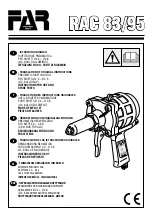
customerservice@focus-ontools.com
2
1-800-348-5004
Characteristic
Minimum Operating Air Pressure
Maximum Operating Air Pressure
Air Inlet
Tool Weight
Nail size
Value
70 PSI
100 PSI
1/4" NPT
1.87 lbs
MAX
SPECIFICATIONS
SAVE THIS INSTRUCTION
You will need the instructions for the safety warning and precautions, assembly instructions, operating and
maintains procedures, parts list and diagram. Keep your invoice with these instruction. Write the invoice
number on the inside of the front cover. Keep the instructions and invoice in a safe and dry place for future
reference.
READ ALL INSTRUCTIONS BEFORE OPERATING THE TOOL
SAFETY WARNINGS & CAUTIONS
1. KEEP WORK AREA CLEAN.
Cluttered areas invite injuries.
2. KEEP CHILDREN AWAY.
All children should be kept away from the work area. Don't let them handle the
tool.
3. DO NOT OPERATE THIS TOOL IF UNDER THE INFLUENCE OF ALCOHOL OR DRUGS.
Read warning label on prescriptions to determine if your judgment or reflexes are impaired while taking drugs.
If there is any doubt, do not attempt to operate.
4. USE EYE PROTECTION.
Eye protection should conform to ANSI Z87.1 specifications and
provide protection against flying debris from the front and side. Eye protection should be worn when
loading, operating, unloading or servicing this tool.
5. USE EAR PROTECTION.
The working area may include exposure to high noise levels that can lead to
hearing damage.
6. NEVER USE OXYGEN, COMBUSTIBLE GASES, BOTTLED GASES OR HIGH PRESSURE
COMPRESSED GAS AS A POWER SOURCE FOR THIS TOOL.
The tool may explode and cause
serious injury.
7. DRESS SAFELY.
Protective gloves and nonskid footwear or safety shoes are recommended when
working with and operating this tool. Don't wear loose clothing or jewelry. They can get caught in moving parts.
Also, wear a protective hair covering to prevent long hair from getting caught in the tool.
8. DO NOT FIRE TO HARD MATERIALS.
Do not attempt to discharge tool into hard or brittle material
such as concrete, steel or tile.
9. DO NOT OVERREACH.
Keep proper footing and balance at all times.
10. CHECK DAMAGED PARTS.
Before using any tool, any part that is damaged should be carefully
checked to determine that it operates properly and perform its intended function.
4-3/4
"
























